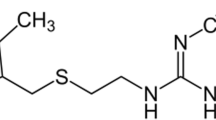Abstract
Although phase-solubility studies have often been used to evaluate the interaction of cyclodextrins (CDs) with various drugs, hundreds of milligrams of both CD and drug are required to prepare a phase diagram. A method that would require considerably less material for evaluating complex formation between a CD and guest compound is therefore needed. We previously reported the detection of the interactions between β-CD and various drugs using a Biacore® system. In this study, we succeeded in immobilizing 6-monodeoxy-6-monoamino-γ-CD on the gold surface of a sensor chip and in detecting the interactions between the immobilized γ-CD and various drugs. The interaction processes were kinetically analyzed using Biacore®. The surface plasmon resonance sensorgrams indicated that the association and dissociation rates of the interactions between γ-CD and drugs were faster than those between β-CD and drugs. Although the association constants calculated from the sensorgrams were smaller than those calculated from phase-solubility studies, good correlation was shown between these data.





Similar content being viewed by others
References
Higuchi, T., Connors, K.A.: Phase-solubility techniques. Adv. Anal. Chem. Instrum. 4, 117–212 (1965)
Homola, J., Yee, S.S., Gauglitz, G.: Surface plasmon resonance sensors: review. Sens. Actuat. B: Chem 54, 3–15 (1999)
Kobayashi, H., Endo, T., Ogawa, N., Nagase, H., Iwata, M., Ueda, H.: Evaluation of the interaction between β-cyclodextrin and psychotropic drugs by surface plasmon resonance assay with a Biacore® system. J. Pharm. Biomed. Anal. in press
Khan, A.R., Forgo, P., Stine, K.J., D’Souza, V.T.: Methods for selective modifications of cyclodextrins. Chem. Rev. 98, 1977–1996 (1998)
Cavalli, R., Trotta, F., Torotta, M., Pastero, L., Aquilano, D.: Effect of alkylcarbonates of γ-cyclodextrins with different chain lengths on drug complexation and release characteristics. Int. J. Pharm. 339, 197–204 (2007)
Yusuff, N., York, P.: Spironolactone-cyclodextrin complexes: Phase solubility and ultrafiltration studies. Int. J. Pharm. 73, 9–15 (1991)
Fujita, K., Chen, W.H., Yuan, D.Q., Nogami, Y., Koga, T., Fujioka, T., Mihashi, K., Immel, S., Lichtenthaler, F.W.: Guest-induced conformational change in a flexible host: Mono-altro-β-cyclodextrin. Tetrahedron Asymmetr. 10, 1689–1696 (1999)
Mitchell, J.S., Wu, Y., Cook, C.J., Main, L.: Sensitivity enhancement of surface plasmon resonance biosensing of small molecules. Anal. Biochem. 343, 125–135 (2005)
Miyazawa, I., Ueda, H., Nagase, H., Endo, T., Kobayashi, S., Nagai, T.: Physicochemical properties and inclusion complex formation of δ-cyclodextrin. Eur. J. Pharm. Sci. 3, 153–162 (1995)
Acknowledgements
This work was supported in part by a grant from the Ministry of Education, Culture, Sports, Science and Technology of Japan.
Author information
Authors and Affiliations
Corresponding author
Rights and permissions
About this article
Cite this article
Abe, K., Ogawa, N., Nagase, H. et al. Evaluation of the abilities of γ-cyclodextrin to form complexes by surface plasmon resonance with a Biacore® system. J Incl Phenom Macrocycl Chem 70, 385–388 (2011). https://doi.org/10.1007/s10847-010-9883-4
Received:
Accepted:
Published:
Issue Date:
DOI: https://doi.org/10.1007/s10847-010-9883-4




